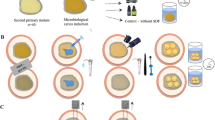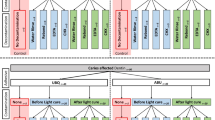Abstract
The aim of this study was to evaluate the effect of SPP with either fetal bovine serum (FBS) or deionized water (DW) on the bond strength (μTBS) of a Universal adhesive to dentin, in both etch-and-rinse (ER) and self-etch (SE) modes. The kinematic viscosity (cSt) of FBS and DW was measured at 25 °C ± 0.1 ºC. Seventy-two sound human molars were sectioned and randomly divided into three groups according to the SPP conditions: (1) Control (0 cm H2O), (2) SPP (15 cm H2O) with FBS, (3) SPP (15 cm H2O) with DW. Each group was subdivided (n = 10) based on the bonding modes: ER (37% phosphoric acid + ScothBond Universal Adhesive) or SE (ScothBond Universal Adhesive). Samples were then submitted to μTBS. Data were analyzed by Student’s t test, two-way ANOVA and Tukey tests (p < 0.05). The cSt results showed that DW (23.59 ± 0.39) had significantly higher values than FBS (22.33 ± 0.06). With regard to SPP, the control group (36.1 MPa) had significantly higher values of μTBS when compared to the SPP using FBS (31.06 MPa) and SPP with DW (26.55 MPa). According to ANOVA, the bonding modes and the interaction of simulated pulpal pressure (SPP) did not statistically influence the results (p < 0.05). The presence of SPP reduced the bond strength of Universal adhesive to dentin. DW during SPP had significantly reduced bonding values when compared to FBS. Bonding strategies were not affected by SPP when evaluated in a short period of time (24 h).



Similar content being viewed by others
References
Buonocore MG. A simple method of increasing the adhesion of acrylic filling materials to enamel surfaces. J Dent Res. 1955;34(6):849–53. https://doi.org/10.1177/00220345550340060801.
Gonçalves SE, Cruz N, Brayner R, Huhtala MF, Borges AB, Barcellos DC. Grander system: a new technology to reduce surface tension of adhesive systems in dentistry. Acta Odontol Scand. 2014;72(1):31–5. https://doi.org/10.3109/00016357.2013.794953.
Torres GB, da Silva TM, Basting RT, Bridi EC, França FMG, Turssi CP, do Amaral FLB, de Depaiva SE, Basting RT. Resin-dentin bond stability and physical characterization of a two-step self-etching adhesive system associated with TiF4. Dent Mater. 2017;33(10):1157–70. https://doi.org/10.1016/j.dental.2017.07.016.
Van Meerbeek B, Yoshihara K, Yoshida Y, Mine A, De Munck J, Van Landuyt KL. State of the art of self-etch adhesives. Dent Mater. 2011;27(1):17–28. https://doi.org/10.1016/j.dental.2010.10.023.
Loguercio AD, de Paula EA, Hass V, Luque-Martinez I, Reis A, Perdigão J. A new universal simplified adhesive: 36 month randomized double-blind clinical trial. J Dent. 2015;43(9):1083–92. https://doi.org/10.1016/j.jdent.2015.07.005.
Pashley EL, Tao L, Derkson G, Pashley DH. Dentin permeability and bond strengths after various surface treatments. Dent Mater. 1989;5(6):375–8. https://doi.org/10.1016/0109-5641(89)90103-6.
Hashimoto M, Ito S, Tay FR, Svizero NR, Sano H, Kaga M, Pashley DH. Fluid movement across the resin-dentin interface during and after bonding. J Dent Res. 2004;83(11):843–8. https://doi.org/10.1177/154405910408301104.
Van Meerbeek B, Yoshihara K, van Landuyt K, Yoshida Y, Peumans M. From Buonocore’s pioneering acid-etch technique to self-adhering restoratives. A status perspective of rapidly advancing dental adhesive technology. J Adhes Dent. 2020;22(1):7–34. https://doi.org/10.3290/j.jad.a43994.
Perdigão J. Current perspectives on dental adhesion: (1) Dentin adhesion—not there yet. Jap Dent Sci Review. 2020;56(1):190–207.
Yoshihara K, Yoshida Y, Nagaoka N, Hayakawa S, Okihara T, De Munck J, et al. Adhesive interfacial interaction affected by different carbon-chain monomers. Dent Mater. 2013;29:888–97.
Leite MLA, Costa CAS, Duarte RM, Andrade AKM, Soares DG. Bond strength and cytotoxicity of a universal adhesive according to the hybridization strategies to dentin. Braz Dent J. 2018;29(1):68–75.
Hosaka K, Nakajima M, Yamauti M, Aksornmuang J, Ikeda M, Foxton RM, Pashley DH, Tagami J. Effect of simulated pulpal pressure on all-in-one adhesive bond strengths to dentine. J Dent. 2007;35(3):207–13. https://doi.org/10.1016/j.jdent.2006.08.001.
Tay FR, Pashley DH, Garcìa-Godoy F, Yiu CK. Single-step, self-etch adhesives behave as permeable membranes after polymerization. Part II. Silver tracer penetration evidence. Am J Dent. 2004;17(5):315–22.
Tay FR, Pashley DH, Suh B, Carvalho R, Miller M. Single-step, self-etch adhesives behave as permeable membranes after polymerization. Part I. Bond strength and morphologic evidence. Am J Dent. 2004;17(4):271–8.
Silva TM, Gonçalves LL, Siqueira EP, Pereira TC, Pontes SO, Grecca AR, Lopes SR, Gonçalves SEP. Influence of simulated pulpal pressure on the variation of intrapulpal temperature during adhesive system light-curing. Braz Dent Sci. 2017;20(2):55–61. https://doi.org/10.1007/s10103-016-2098-1.
Paris Matos T, Perdigão J, de Paula E, Coppla F, Hass V, Scheffer RF, et al. Five-year clinical evaluation of a universal adhesive: a randomized double-blind trial. Dent Mater. 2020. https://doi.org/10.1016/j.dental.2020.08.007.
Nikaido T, Burrow MF, Tagami J, Takatsu T. Effect of pulpal pressure on adhesion of resin composite to dentin: bovine serum versus saline. Quintessence Int. 1995;26(3):221–6.
Mobarak EH, El-Deeb HA, Yousry MM. Influence of different intrapulpal pressure simulation liquids on the microtensile bond strength of adhesive systems to dentin. J Adhes Dent. 2013;15(6):519–26. https://doi.org/10.3290/j.jad.a29719.
Sauro S, Pashley DH, Montanari M, Chersoni S, Carvalho RM, Toledano M, et al. Effect of simulated pulpal pressure on dentin permeability and adhesion of self-etch adhesives. Dent Mater. 2007;23(6):705–13. https://doi.org/10.1016/j.dental.2006.06.010.
Hosaka K, Nakajima M, Monticelli F, Carrilho M, Yamauti M, Aksornmuang J, et al. Influence of hydrostatic pulpal pressure on the microtensile bond strength of all-in-one self-etching adhesives. J Adhes Dent. 2007;9(5):437–42.
Santis LR, Silva TM, Haddad BA, Gonçalves LL, Gonçalves SEP. Influence of dentin thickness on intrapulpal temperature under simulated pulpal pressure during Nd:YAG laser irradiation. Lasers Med Sci. 2017;32(1):161–7. https://doi.org/10.1007/s10103-016-2098-1.
Belli R, Sartori N, Peruchi LD, Guimarães JC, Araújo E, Monteiro S Jr, Baratieri LN, Lohbauer U. Slow progression of dentin bond degradation during one-year water storage under simulated pulpal pressure. J Dent. 2010;38(10):802–10. https://doi.org/10.1016/j.jdent.2010.06.012.
Goodis HE, White JM, Marshall GW Jr, Yee K, Fuller N, Gee L, Marshall SJ. Effects of Nd: and Ho:yttrium-aluminium-garnet lasers on human dentine fluid flow and dental pulp-chamber temperature in vitro. Arch Oral Biol. 1997;42(12):845–54. https://doi.org/10.1016/s0003-9969(97)00076-9.
Özok AR, Wu MK, De Gee AJ, Wesselink PR. Effect of dentin perfusion on the sealing ability and microtensile bond strengths of a total-etch versus an all-in-one adhesive. Dent Mater. 2004;20(5):479–86. https://doi.org/10.1016/j.dental.2003.07.004.
Roulet JF, Van Meerbeek B. Statistics: a nuisance, a tool, or a must? J Adhes Dent. 2007;9(3):287–8.
Perote LCCC, Kamozaki MBB, Gutierrez NC, Tay FR, Pucci CR. Effect of matrix metalloproteinase-inhibiting solutions and aging methods on dentin bond strength. J Adhes Dent. 2015;17(4):347–52. https://doi.org/10.3290/j.jad.a34594.
Perdigão J. Dentin bonding-variables related to the clinical situation and the substrate treatment. Dent Mater. 2010;26(2):e24-37. https://doi.org/10.1016/j.dental.2009.11.149.
Özok AR, Wu MK, Wesselink PR. Comparison of the in vitro permeability of human dentine according to the dentinal region and the composition of the simulated dentinal fluid. J Dent. 2002;30(2–3):107–11. https://doi.org/10.1016/s0300-5712(02)00005-2.
Augustin C, Paul SJ, Lüthy H, Schärer P. Perfusing dentine with horse serum or physiologic saline: Its effect on adhesion of dentine bonding agents. J Oral Rehabil. 1998;25(8):596–602602. https://doi.org/10.1046/j.1365-2842.1998.00276.x.
Schaller J, Gerber S, Kämpfer U, Lejon S, Trachsel C. Human blood plasma proteins: structure and function. New Jersey: Wiley; 2008. https://doi.org/10.1002/9780470724378.
Gernhardt CR, Bekes K, Fechner K, Schaller HG. The influence of human plasma used for in vitro dentin perfusion on microtensile bond strength of 5 self-conditioning dentin adhesives. Quintessence Int. 2006;37(6):429–35.
Paul SJ, Leach M, Rueggeberg FA, Pashley DH. Effect of water content on the physical properties of model dentine primer and bonding resins. J Dent. 1999;27(3):209–14. https://doi.org/10.1016/s0300-5712(98)00042-6.
Ito S, Hashimoto M, Wadgaonkar B, Svizero N, Carvalho RM, Yiu C, et al. Effects of resin hydrophilicity on water sorption and changes in modulus of elasticity. Biomaterials. 2005;26(33):6449–59. https://doi.org/10.1016/j.biomaterials.2005.04.052.
Spencer P, Ye Q, Park J, Misra A, Bohaty BS, Singh V, Parthasarathy R, Sene F, Gonçalves SEP, Laurence J. Durable bonds at the adhesive/dentin interface: an impossible mission or simply a moving target? Braz Dent Sci. 2012;15:4–18. https://doi.org/10.14295/bds.2012.v15i1.790.
Escribano N, Del-Nero O, La MJCD. Sealing and dentin bond strength of adhesive systems in selected areas of perfused teeth. Dent Mater. 2001;17(2):149–55. https://doi.org/10.1016/s0109-5641(00)00057-9.
Muñoz MA, Luque-Martinez I, Malaquias P, Hass V, Reis A, Campanha NH, et al. In vitro longevity of bonding properties of universal adhesives to dentin. Oper Dent. 2015;40(3):282–92. https://doi.org/10.2341/14-055-L.
Da Rosa WLDO, Piva E, Da Silva AF. Bond strength of universal adhesives: a systematic review and meta-analysis. J Dent. 2015;43(7):765–76. https://doi.org/10.1016/j.jdent.2015.04.003.
Mazzitelli C, Monticelli F, Osorio R, Casucci A, Toledano M, Ferrari M. Effect of simulated pulpal pressure on self-adhesive cements bonding to dentin. Dent Mater. 2008;24(9):1156–63.
Feitosa VP, Correr AB, Correr-Sobrinho L, Sinhoreti MA. Effect of a new method to simulate pulpal pressure on bond strength and nanoleakage of dental adhesives to dentin. J Adhes Dent. 2012;14(6):517–24.
Ikeda M, Tsubota K, Takamizawa T, Yoshida T, Miyazaki M, Platt JA. Bonding durability of single-step adhesives to previously acid-etched dentin. Oper Dent. 2008;33(6):702–9. https://doi.org/10.2341/08-26.
Langer A, Ilie N. Dentin infiltration ability of different classes of adhesive systems. Clin Oral Investig. 2013;17(1):205–16. https://doi.org/10.1007/s00784-012-0694-4.
Wagner A, Wendler M, Petschelt A, Belli R, Lohbauer U. Bonding performance of universal adhesives in different etching modes. J Dent. 2014;42(7):800–7. https://doi.org/10.1016/j.jdent.2014.04.012.
Tay FR, Pashley DH. Aggressiveness of contemporary self-etching systems. I: depth of penetration beyond dentin smear layers. Dent Mater. 2001;17(4):296–308. https://doi.org/10.1016/s0109-5641(00)00087-7.
Feitosa VP, Leme AA, Sauro S, Correr Sobrinho L, Watson TF, Sinhoreti MA, Correr AB. Hydrolytic degradation of the resin-dentin interface induced by the simulated pulpal pressure, direct and indirect water aging. J Dent. 2012;40:1134–43.
Pucci CR, Gu LS, Zeng C, Gou YP, Tay FR, Niu LN. Susceptibility of contemporary single-bottle self-etch dentine adhesives to intrinsic water permeation. J Dent. 2017;66:52–61.
Cardoso GC, Nakanishi L, Isolan CP, Jardim PDS, Moraes RR. Bond stability of universal adhesives applied to dentin using etch-and-rinse or self-etch strategies. Braz Dent J. 2019;30(5):467–75.
Sezinando A, Serrano ML, Pérez VM, Muñoz RGA, Ceballos L, Perdigão J. Chemical adhesion of polyalkenoate-based adhesives to hydroxyapatite. J Adhes Dent. 2016;18(3):257–65. https://doi.org/10.3290/j.jad.a36222.
Funding
The work was supported by the Department Restorative Dentistry, Institute of Science and technology. UNESP–Univ Estadual Paulista, São José dos Campos, SP, Brazil.
Author information
Authors and Affiliations
Corresponding author
Ethics declarations
Conflict of interest
Authors declare that have no conflict of interest.
Ethical approval
This article does not contain any studies with human participants or animals performed by any of the authors.
Informed consent
For this type of study, formal consent is not required.
Additional information
Publisher's Note
Springer Nature remains neutral with regard to jurisdictional claims in published maps and institutional affiliations.
Rights and permissions
About this article
Cite this article
Gonçalves, L.L., Da Silva, T.M., Prakki, A. et al. Universal adhesive: the effect of different simulated pulpal pressure fluids and bonding modes to dentin. Odontology 110, 62–69 (2022). https://doi.org/10.1007/s10266-021-00633-0
Received:
Accepted:
Published:
Issue Date:
DOI: https://doi.org/10.1007/s10266-021-00633-0




